Nursing Assessment for Complex Clinical Care: Preventing Failure
VerifiedAdded on 2020/12/30
|11
|3399
|350
Report
AI Summary
This report provides a comprehensive analysis of nursing assessments for complex clinical care, focusing on the prevention of clinical management failures within an Australian hospital setting. The introduction defines complex clinical care and adverse events, highlighting their impact on patients, families, and the healthcare system. The report then examines the prevalence of clinical management failures, exploring contributing factors such as medication errors, documentation errors, and lack of communication. It evaluates the effects of these failures on patients, families, and the healthcare system, including emotional and financial impacts. The core of the report focuses on critical evaluation, outlining nursing strategies to prevent clinical management failures, such as reducing medication errors and improving documentation. It also analyzes barriers to implementing these strategies, including time constraints, lack of knowledge, and communication issues, and proposes methods to overcome these barriers, ultimately promoting patient safety. The report concludes by summarizing key findings and emphasizing the importance of proactive measures to improve patient outcomes.
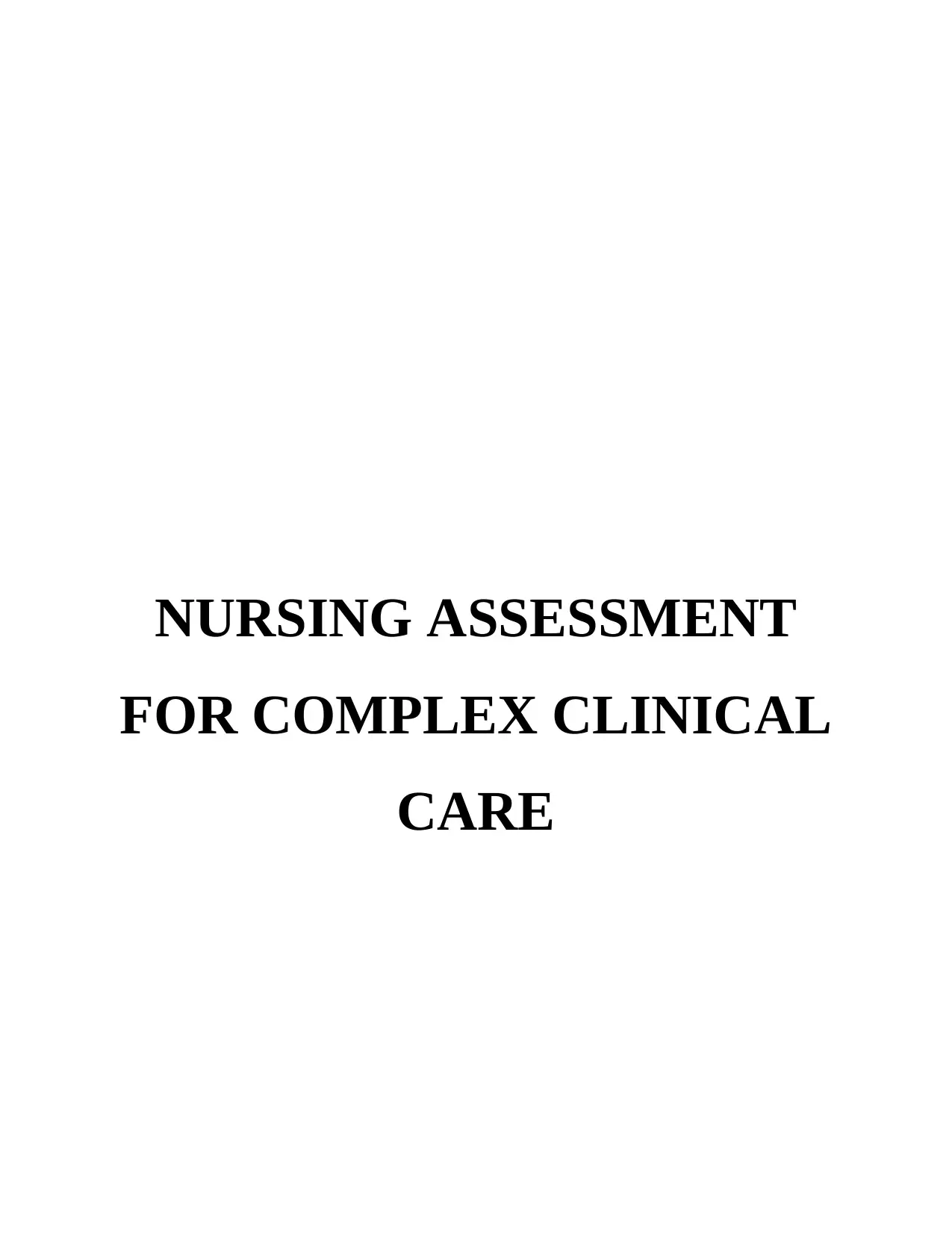
NURSING ASSESSMENT
FOR COMPLEX CLINICAL
CARE
FOR COMPLEX CLINICAL
CARE
Paraphrase This Document
Need a fresh take? Get an instant paraphrase of this document with our AI Paraphraser
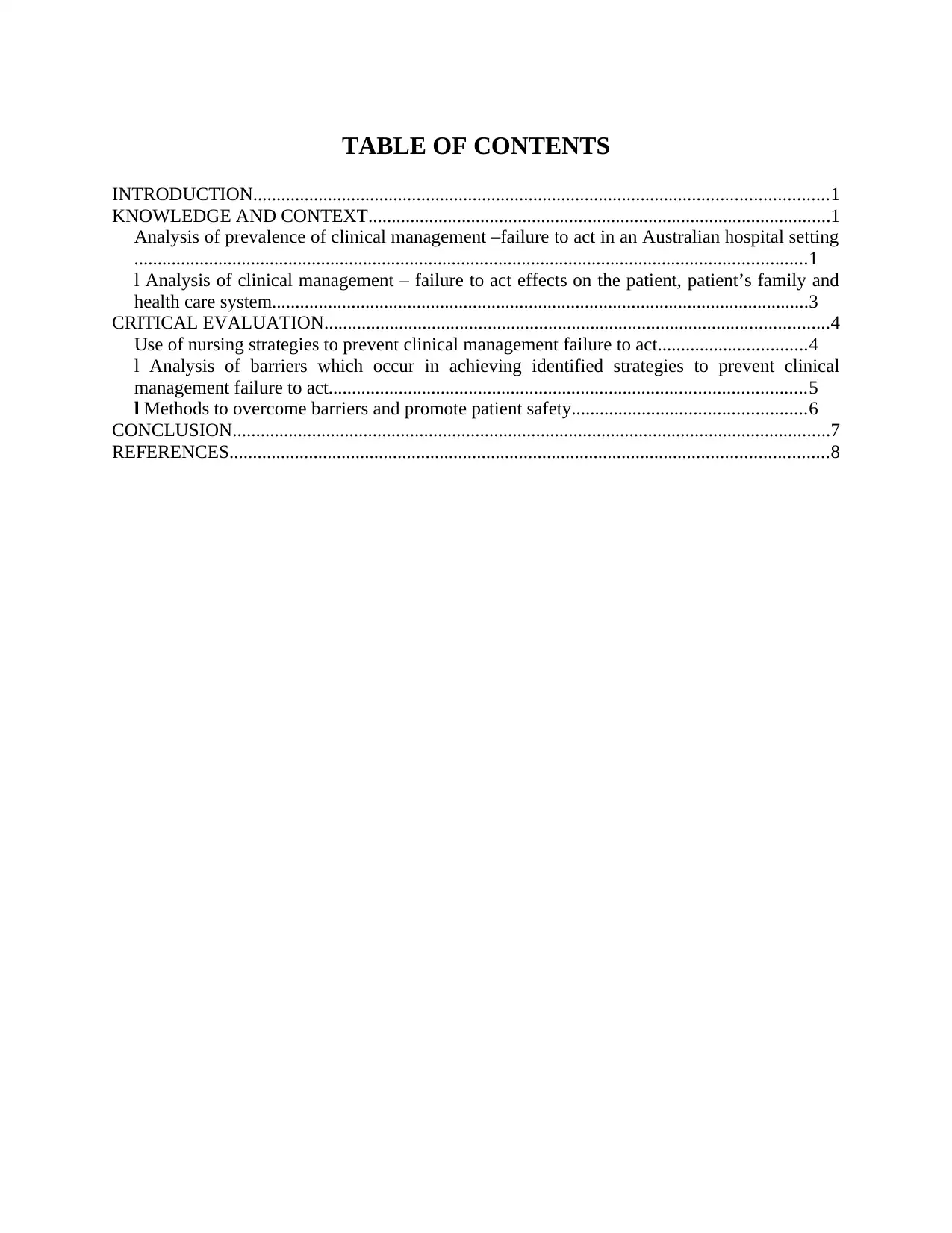
TABLE OF CONTENTS
INTRODUCTION...........................................................................................................................1
KNOWLEDGE AND CONTEXT...................................................................................................1
Analysis of prevalence of clinical management –failure to act in an Australian hospital setting
................................................................................................................................................1
l Analysis of clinical management – failure to act effects on the patient, patient’s family and
health care system...................................................................................................................3
CRITICAL EVALUATION............................................................................................................4
Use of nursing strategies to prevent clinical management failure to act................................4
l Analysis of barriers which occur in achieving identified strategies to prevent clinical
management failure to act......................................................................................................5
l Methods to overcome barriers and promote patient safety..................................................6
CONCLUSION................................................................................................................................7
REFERENCES................................................................................................................................8
INTRODUCTION...........................................................................................................................1
KNOWLEDGE AND CONTEXT...................................................................................................1
Analysis of prevalence of clinical management –failure to act in an Australian hospital setting
................................................................................................................................................1
l Analysis of clinical management – failure to act effects on the patient, patient’s family and
health care system...................................................................................................................3
CRITICAL EVALUATION............................................................................................................4
Use of nursing strategies to prevent clinical management failure to act................................4
l Analysis of barriers which occur in achieving identified strategies to prevent clinical
management failure to act......................................................................................................5
l Methods to overcome barriers and promote patient safety..................................................6
CONCLUSION................................................................................................................................7
REFERENCES................................................................................................................................8
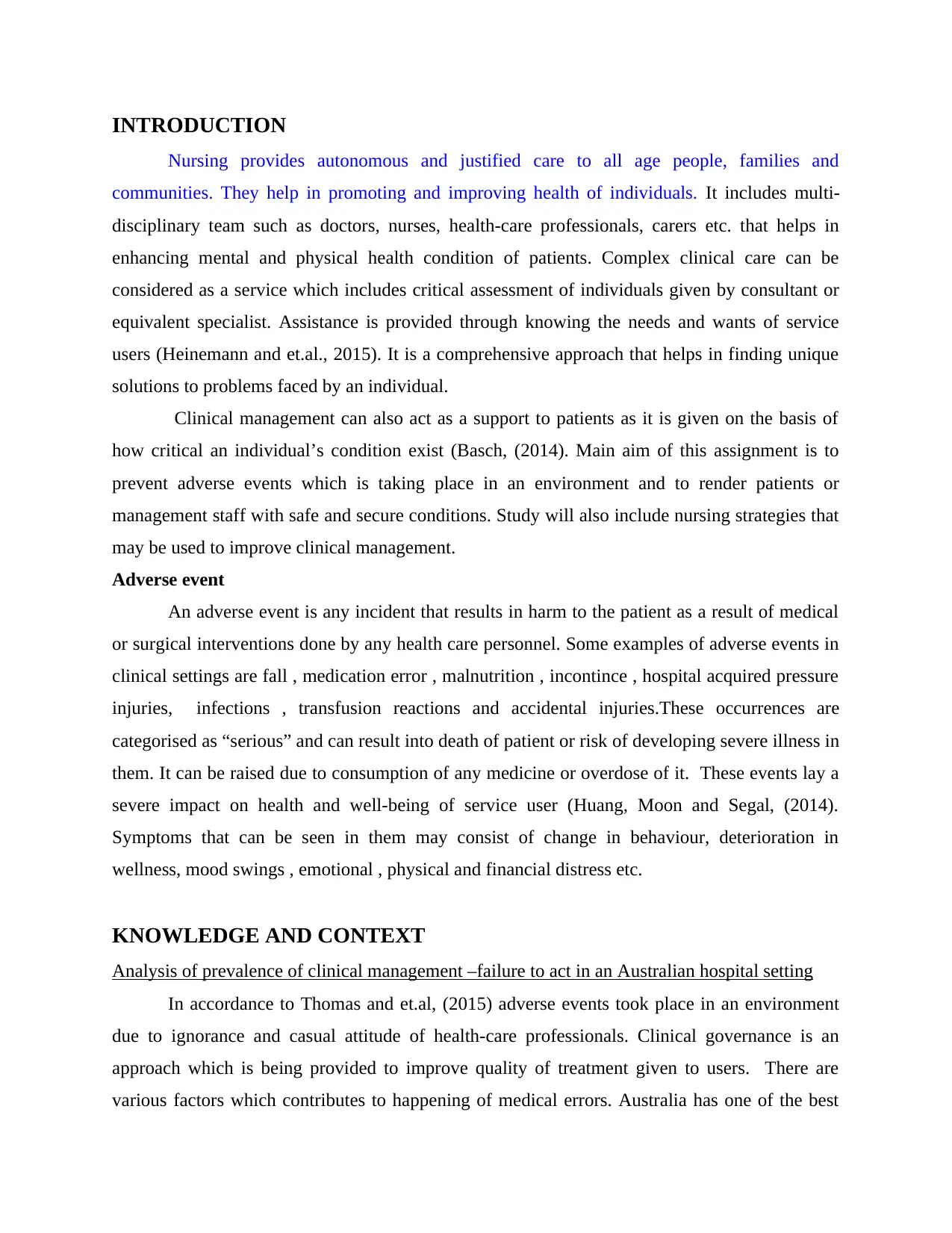
INTRODUCTION
Nursing provides autonomous and justified care to all age people, families and
communities. They help in promoting and improving health of individuals. It includes multi-
disciplinary team such as doctors, nurses, health-care professionals, carers etc. that helps in
enhancing mental and physical health condition of patients. Complex clinical care can be
considered as a service which includes critical assessment of individuals given by consultant or
equivalent specialist. Assistance is provided through knowing the needs and wants of service
users (Heinemann and et.al., 2015). It is a comprehensive approach that helps in finding unique
solutions to problems faced by an individual.
Clinical management can also act as a support to patients as it is given on the basis of
how critical an individual’s condition exist (Basch, (2014). Main aim of this assignment is to
prevent adverse events which is taking place in an environment and to render patients or
management staff with safe and secure conditions. Study will also include nursing strategies that
may be used to improve clinical management.
Adverse event
An adverse event is any incident that results in harm to the patient as a result of medical
or surgical interventions done by any health care personnel. Some examples of adverse events in
clinical settings are fall , medication error , malnutrition , incontince , hospital acquired pressure
injuries, infections , transfusion reactions and accidental injuries.These occurrences are
categorised as “serious” and can result into death of patient or risk of developing severe illness in
them. It can be raised due to consumption of any medicine or overdose of it. These events lay a
severe impact on health and well-being of service user (Huang, Moon and Segal, (2014).
Symptoms that can be seen in them may consist of change in behaviour, deterioration in
wellness, mood swings , emotional , physical and financial distress etc.
KNOWLEDGE AND CONTEXT
Analysis of prevalence of clinical management –failure to act in an Australian hospital setting
In accordance to Thomas and et.al, (2015) adverse events took place in an environment
due to ignorance and casual attitude of health-care professionals. Clinical governance is an
approach which is being provided to improve quality of treatment given to users. There are
various factors which contributes to happening of medical errors. Australia has one of the best
Nursing provides autonomous and justified care to all age people, families and
communities. They help in promoting and improving health of individuals. It includes multi-
disciplinary team such as doctors, nurses, health-care professionals, carers etc. that helps in
enhancing mental and physical health condition of patients. Complex clinical care can be
considered as a service which includes critical assessment of individuals given by consultant or
equivalent specialist. Assistance is provided through knowing the needs and wants of service
users (Heinemann and et.al., 2015). It is a comprehensive approach that helps in finding unique
solutions to problems faced by an individual.
Clinical management can also act as a support to patients as it is given on the basis of
how critical an individual’s condition exist (Basch, (2014). Main aim of this assignment is to
prevent adverse events which is taking place in an environment and to render patients or
management staff with safe and secure conditions. Study will also include nursing strategies that
may be used to improve clinical management.
Adverse event
An adverse event is any incident that results in harm to the patient as a result of medical
or surgical interventions done by any health care personnel. Some examples of adverse events in
clinical settings are fall , medication error , malnutrition , incontince , hospital acquired pressure
injuries, infections , transfusion reactions and accidental injuries.These occurrences are
categorised as “serious” and can result into death of patient or risk of developing severe illness in
them. It can be raised due to consumption of any medicine or overdose of it. These events lay a
severe impact on health and well-being of service user (Huang, Moon and Segal, (2014).
Symptoms that can be seen in them may consist of change in behaviour, deterioration in
wellness, mood swings , emotional , physical and financial distress etc.
KNOWLEDGE AND CONTEXT
Analysis of prevalence of clinical management –failure to act in an Australian hospital setting
In accordance to Thomas and et.al, (2015) adverse events took place in an environment
due to ignorance and casual attitude of health-care professionals. Clinical governance is an
approach which is being provided to improve quality of treatment given to users. There are
various factors which contributes to happening of medical errors. Australia has one of the best
⊘ This is a preview!⊘
Do you want full access?
Subscribe today to unlock all pages.

Trusted by 1+ million students worldwide

health-care system in world. However, no organisation is perfect (Huang, Moon and Segal,
(2014). There are some medical incidents which has occurred on path of them. Components
comprising for failure in clinical management may include inability to take precaution after
accidental injury, delay in diagnosis, failure to take any assessment test such as CT scan, ECG
etc., unable to react when going through results of mental measurement. Adverse events may
also take place in hospital due to therapy, drug, medication, fracture and anaesthetic errors .
2
(2014). There are some medical incidents which has occurred on path of them. Components
comprising for failure in clinical management may include inability to take precaution after
accidental injury, delay in diagnosis, failure to take any assessment test such as CT scan, ECG
etc., unable to react when going through results of mental measurement. Adverse events may
also take place in hospital due to therapy, drug, medication, fracture and anaesthetic errors .
2
Paraphrase This Document
Need a fresh take? Get an instant paraphrase of this document with our AI Paraphraser
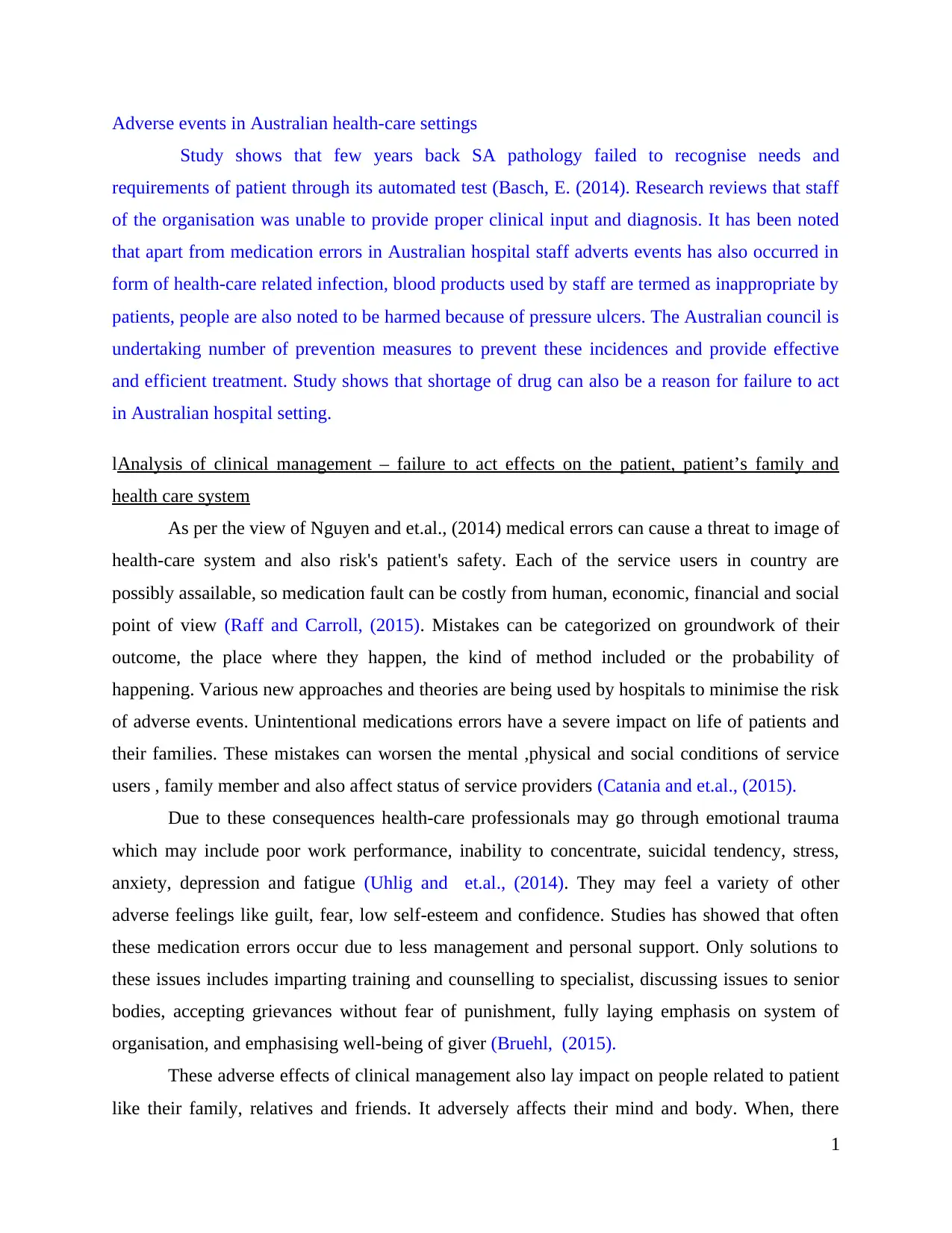
Adverse events in Australian health-care settings
Study shows that few years back SA pathology failed to recognise needs and
requirements of patient through its automated test (Basch, E. (2014). Research reviews that staff
of the organisation was unable to provide proper clinical input and diagnosis. It has been noted
that apart from medication errors in Australian hospital staff adverts events has also occurred in
form of health-care related infection, blood products used by staff are termed as inappropriate by
patients, people are also noted to be harmed because of pressure ulcers. The Australian council is
undertaking number of prevention measures to prevent these incidences and provide effective
and efficient treatment. Study shows that shortage of drug can also be a reason for failure to act
in Australian hospital setting.
lAnalysis of clinical management – failure to act effects on the patient, patient’s family and
health care system
As per the view of Nguyen and et.al., (2014) medical errors can cause a threat to image of
health-care system and also risk's patient's safety. Each of the service users in country are
possibly assailable, so medication fault can be costly from human, economic, financial and social
point of view (Raff and Carroll, (2015). Mistakes can be categorized on groundwork of their
outcome, the place where they happen, the kind of method included or the probability of
happening. Various new approaches and theories are being used by hospitals to minimise the risk
of adverse events. Unintentional medications errors have a severe impact on life of patients and
their families. These mistakes can worsen the mental ,physical and social conditions of service
users , family member and also affect status of service providers (Catania and et.al., (2015).
Due to these consequences health-care professionals may go through emotional trauma
which may include poor work performance, inability to concentrate, suicidal tendency, stress,
anxiety, depression and fatigue (Uhlig and et.al., (2014). They may feel a variety of other
adverse feelings like guilt, fear, low self-esteem and confidence. Studies has showed that often
these medication errors occur due to less management and personal support. Only solutions to
these issues includes imparting training and counselling to specialist, discussing issues to senior
bodies, accepting grievances without fear of punishment, fully laying emphasis on system of
organisation, and emphasising well-being of giver (Bruehl, (2015).
These adverse effects of clinical management also lay impact on people related to patient
like their family, relatives and friends. It adversely affects their mind and body. When, there
1
Study shows that few years back SA pathology failed to recognise needs and
requirements of patient through its automated test (Basch, E. (2014). Research reviews that staff
of the organisation was unable to provide proper clinical input and diagnosis. It has been noted
that apart from medication errors in Australian hospital staff adverts events has also occurred in
form of health-care related infection, blood products used by staff are termed as inappropriate by
patients, people are also noted to be harmed because of pressure ulcers. The Australian council is
undertaking number of prevention measures to prevent these incidences and provide effective
and efficient treatment. Study shows that shortage of drug can also be a reason for failure to act
in Australian hospital setting.
lAnalysis of clinical management – failure to act effects on the patient, patient’s family and
health care system
As per the view of Nguyen and et.al., (2014) medical errors can cause a threat to image of
health-care system and also risk's patient's safety. Each of the service users in country are
possibly assailable, so medication fault can be costly from human, economic, financial and social
point of view (Raff and Carroll, (2015). Mistakes can be categorized on groundwork of their
outcome, the place where they happen, the kind of method included or the probability of
happening. Various new approaches and theories are being used by hospitals to minimise the risk
of adverse events. Unintentional medications errors have a severe impact on life of patients and
their families. These mistakes can worsen the mental ,physical and social conditions of service
users , family member and also affect status of service providers (Catania and et.al., (2015).
Due to these consequences health-care professionals may go through emotional trauma
which may include poor work performance, inability to concentrate, suicidal tendency, stress,
anxiety, depression and fatigue (Uhlig and et.al., (2014). They may feel a variety of other
adverse feelings like guilt, fear, low self-esteem and confidence. Studies has showed that often
these medication errors occur due to less management and personal support. Only solutions to
these issues includes imparting training and counselling to specialist, discussing issues to senior
bodies, accepting grievances without fear of punishment, fully laying emphasis on system of
organisation, and emphasising well-being of giver (Bruehl, (2015).
These adverse effects of clinical management also lay impact on people related to patient
like their family, relatives and friends. It adversely affects their mind and body. When, there
1
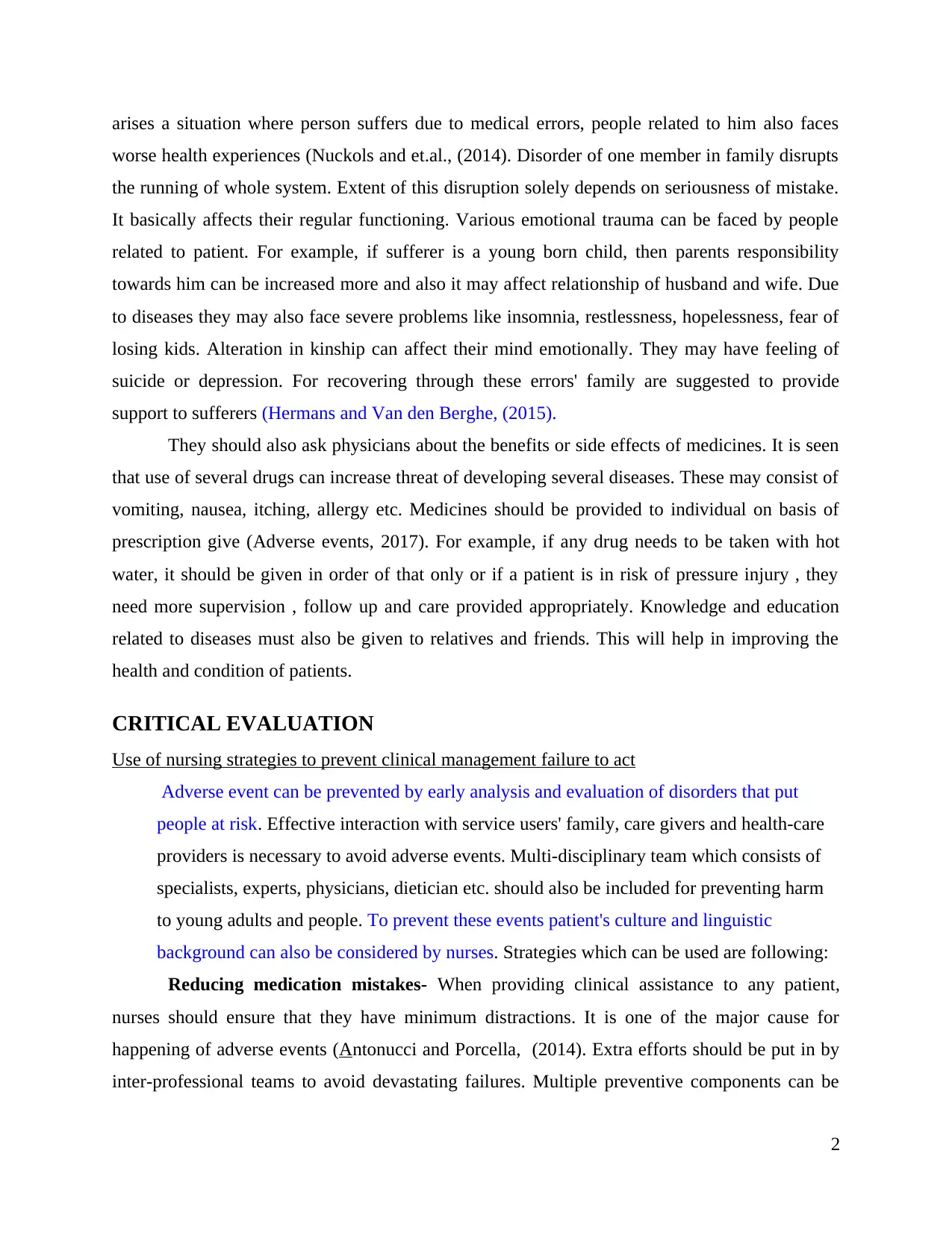
arises a situation where person suffers due to medical errors, people related to him also faces
worse health experiences (Nuckols and et.al., (2014). Disorder of one member in family disrupts
the running of whole system. Extent of this disruption solely depends on seriousness of mistake.
It basically affects their regular functioning. Various emotional trauma can be faced by people
related to patient. For example, if sufferer is a young born child, then parents responsibility
towards him can be increased more and also it may affect relationship of husband and wife. Due
to diseases they may also face severe problems like insomnia, restlessness, hopelessness, fear of
losing kids. Alteration in kinship can affect their mind emotionally. They may have feeling of
suicide or depression. For recovering through these errors' family are suggested to provide
support to sufferers (Hermans and Van den Berghe, (2015).
They should also ask physicians about the benefits or side effects of medicines. It is seen
that use of several drugs can increase threat of developing several diseases. These may consist of
vomiting, nausea, itching, allergy etc. Medicines should be provided to individual on basis of
prescription give (Adverse events, 2017). For example, if any drug needs to be taken with hot
water, it should be given in order of that only or if a patient is in risk of pressure injury , they
need more supervision , follow up and care provided appropriately. Knowledge and education
related to diseases must also be given to relatives and friends. This will help in improving the
health and condition of patients.
CRITICAL EVALUATION
Use of nursing strategies to prevent clinical management failure to act
Adverse event can be prevented by early analysis and evaluation of disorders that put
people at risk. Effective interaction with service users' family, care givers and health-care
providers is necessary to avoid adverse events. Multi-disciplinary team which consists of
specialists, experts, physicians, dietician etc. should also be included for preventing harm
to young adults and people. To prevent these events patient's culture and linguistic
background can also be considered by nurses. Strategies which can be used are following:
Reducing medication mistakes- When providing clinical assistance to any patient,
nurses should ensure that they have minimum distractions. It is one of the major cause for
happening of adverse events (Antonucci and Porcella, (2014). Extra efforts should be put in by
inter-professional teams to avoid devastating failures. Multiple preventive components can be
2
worse health experiences (Nuckols and et.al., (2014). Disorder of one member in family disrupts
the running of whole system. Extent of this disruption solely depends on seriousness of mistake.
It basically affects their regular functioning. Various emotional trauma can be faced by people
related to patient. For example, if sufferer is a young born child, then parents responsibility
towards him can be increased more and also it may affect relationship of husband and wife. Due
to diseases they may also face severe problems like insomnia, restlessness, hopelessness, fear of
losing kids. Alteration in kinship can affect their mind emotionally. They may have feeling of
suicide or depression. For recovering through these errors' family are suggested to provide
support to sufferers (Hermans and Van den Berghe, (2015).
They should also ask physicians about the benefits or side effects of medicines. It is seen
that use of several drugs can increase threat of developing several diseases. These may consist of
vomiting, nausea, itching, allergy etc. Medicines should be provided to individual on basis of
prescription give (Adverse events, 2017). For example, if any drug needs to be taken with hot
water, it should be given in order of that only or if a patient is in risk of pressure injury , they
need more supervision , follow up and care provided appropriately. Knowledge and education
related to diseases must also be given to relatives and friends. This will help in improving the
health and condition of patients.
CRITICAL EVALUATION
Use of nursing strategies to prevent clinical management failure to act
Adverse event can be prevented by early analysis and evaluation of disorders that put
people at risk. Effective interaction with service users' family, care givers and health-care
providers is necessary to avoid adverse events. Multi-disciplinary team which consists of
specialists, experts, physicians, dietician etc. should also be included for preventing harm
to young adults and people. To prevent these events patient's culture and linguistic
background can also be considered by nurses. Strategies which can be used are following:
Reducing medication mistakes- When providing clinical assistance to any patient,
nurses should ensure that they have minimum distractions. It is one of the major cause for
happening of adverse events (Antonucci and Porcella, (2014). Extra efforts should be put in by
inter-professional teams to avoid devastating failures. Multiple preventive components can be
2
⊘ This is a preview!⊘
Do you want full access?
Subscribe today to unlock all pages.

Trusted by 1+ million students worldwide

used by nurses such as Bar coding medication system can be used by multi-disciplinary
workforce to confirm medicament rights like correct patient, route, time, dose and
documentation more effectively. Active role can also be initiated by nurses to consult with inter-
professional team and also effective communication should be held with pharmacy team. This
would help them in knowing that all the like-alike drugs are not kept together. Medicines should
be critically analysed by nurses in order to know their benefits and side effects. Drug guides
should be used by carers as to become familiar with use of medicines. For example, some drugs
are need to be taken with hot water. All the high alert doses should be double-checked with
another nurse. This can help in reducing medication errors (Johnson, Guirguis, and Grace,
(2015). Nurses should be in charge to provide safe and secure environment to patient for their
safety.
Documentation errors- It is the responsibility of health-care professionals to document
every major event and changes happening in patient's body. This is an important drawback for
nurses as often they feel it is not necessary to store all information related to service users. It will
allow them to reduce medication errors (How to avoid 7 nursing errors, (2017). Representation
charts of individual may include sufferers should be monitored daily and interventions related to
document may performed. Adverse events happening in a patient's life should be informed
quickly to senior staff, managers, doctors or physicians. Keeping a check that health-care
professional is regularly monitoring and noting levels of service user's heart rate, blood pressure,
respiratory rate, urine flow etc. Ensuring that all written paper material belongs to correct
patient.All the information related to service user should be kept confidential and secure in order
to maintain patient's safety (Metsälä and Vaherkoski, (2014). For instance, data like age, sex,
economic status should not be shared by hospital staff to anyone other than close relatives of an
individual. Each signs and symptoms of diseases should be noted by nurses. Documents should
be made according to patient's condition. For example, if service users state is declining, note
should be made on basis of that.
lAnalysis of barriers which occur in achieving identified strategies to prevent clinical
management failure to act
Main cause of failure of clinical management is due to negligence and careless attitude of
professional staff, nurses, health-care providers, carers, doctors etc. Various strategies are being
recognised to overcome these medication errors but there can occur some barriers on following
3
workforce to confirm medicament rights like correct patient, route, time, dose and
documentation more effectively. Active role can also be initiated by nurses to consult with inter-
professional team and also effective communication should be held with pharmacy team. This
would help them in knowing that all the like-alike drugs are not kept together. Medicines should
be critically analysed by nurses in order to know their benefits and side effects. Drug guides
should be used by carers as to become familiar with use of medicines. For example, some drugs
are need to be taken with hot water. All the high alert doses should be double-checked with
another nurse. This can help in reducing medication errors (Johnson, Guirguis, and Grace,
(2015). Nurses should be in charge to provide safe and secure environment to patient for their
safety.
Documentation errors- It is the responsibility of health-care professionals to document
every major event and changes happening in patient's body. This is an important drawback for
nurses as often they feel it is not necessary to store all information related to service users. It will
allow them to reduce medication errors (How to avoid 7 nursing errors, (2017). Representation
charts of individual may include sufferers should be monitored daily and interventions related to
document may performed. Adverse events happening in a patient's life should be informed
quickly to senior staff, managers, doctors or physicians. Keeping a check that health-care
professional is regularly monitoring and noting levels of service user's heart rate, blood pressure,
respiratory rate, urine flow etc. Ensuring that all written paper material belongs to correct
patient.All the information related to service user should be kept confidential and secure in order
to maintain patient's safety (Metsälä and Vaherkoski, (2014). For instance, data like age, sex,
economic status should not be shared by hospital staff to anyone other than close relatives of an
individual. Each signs and symptoms of diseases should be noted by nurses. Documents should
be made according to patient's condition. For example, if service users state is declining, note
should be made on basis of that.
lAnalysis of barriers which occur in achieving identified strategies to prevent clinical
management failure to act
Main cause of failure of clinical management is due to negligence and careless attitude of
professional staff, nurses, health-care providers, carers, doctors etc. Various strategies are being
recognised to overcome these medication errors but there can occur some barriers on following
3
Paraphrase This Document
Need a fresh take? Get an instant paraphrase of this document with our AI Paraphraser
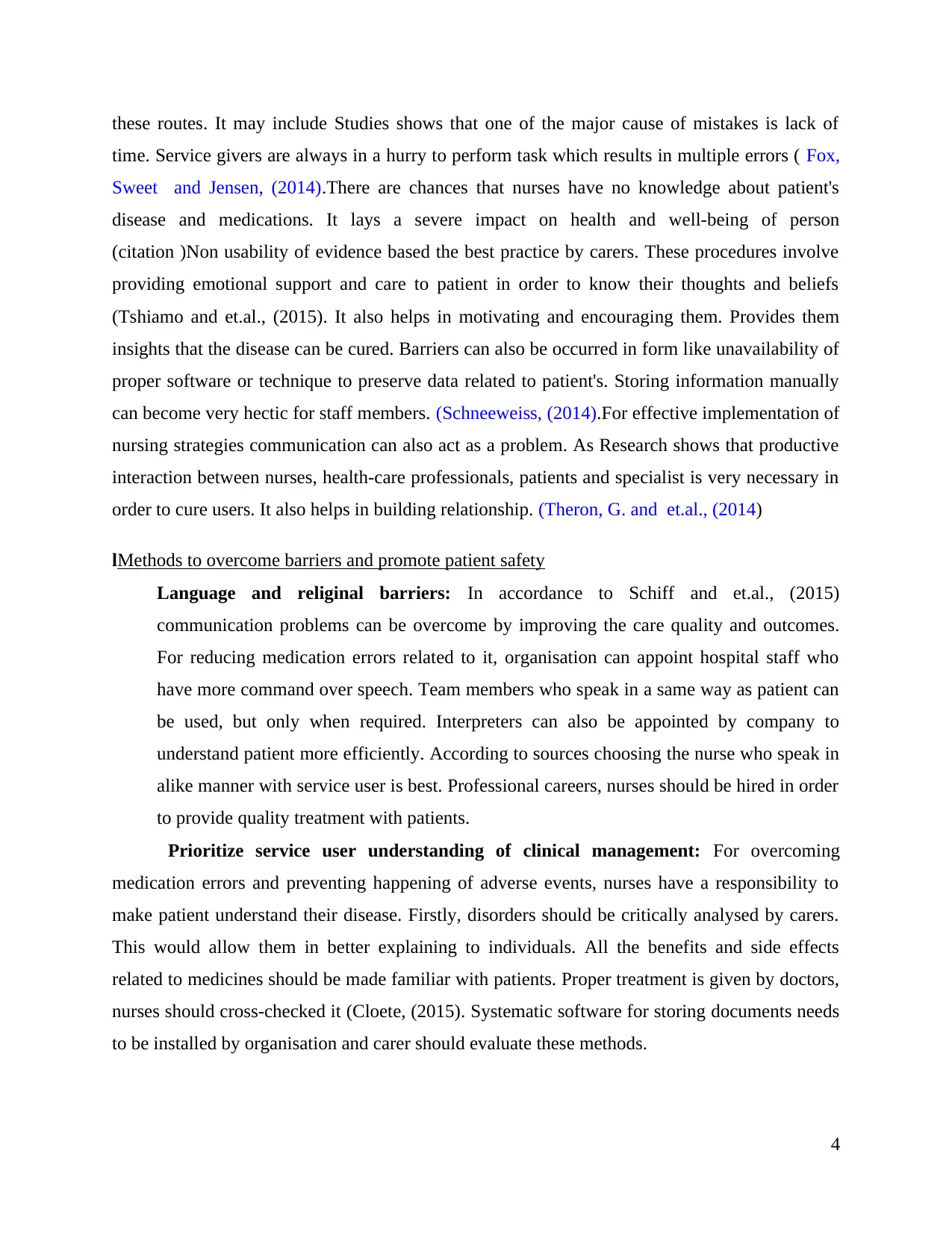
these routes. It may include Studies shows that one of the major cause of mistakes is lack of
time. Service givers are always in a hurry to perform task which results in multiple errors ( Fox,
Sweet and Jensen, (2014).There are chances that nurses have no knowledge about patient's
disease and medications. It lays a severe impact on health and well-being of person
(citation )Non usability of evidence based the best practice by carers. These procedures involve
providing emotional support and care to patient in order to know their thoughts and beliefs
(Tshiamo and et.al., (2015). It also helps in motivating and encouraging them. Provides them
insights that the disease can be cured. Barriers can also be occurred in form like unavailability of
proper software or technique to preserve data related to patient's. Storing information manually
can become very hectic for staff members. (Schneeweiss, (2014).For effective implementation of
nursing strategies communication can also act as a problem. As Research shows that productive
interaction between nurses, health-care professionals, patients and specialist is very necessary in
order to cure users. It also helps in building relationship. (Theron, G. and et.al., (2014)
lMethods to overcome barriers and promote patient safety
Language and religinal barriers: In accordance to Schiff and et.al., (2015)
communication problems can be overcome by improving the care quality and outcomes.
For reducing medication errors related to it, organisation can appoint hospital staff who
have more command over speech. Team members who speak in a same way as patient can
be used, but only when required. Interpreters can also be appointed by company to
understand patient more efficiently. According to sources choosing the nurse who speak in
alike manner with service user is best. Professional careers, nurses should be hired in order
to provide quality treatment with patients.
Prioritize service user understanding of clinical management: For overcoming
medication errors and preventing happening of adverse events, nurses have a responsibility to
make patient understand their disease. Firstly, disorders should be critically analysed by carers.
This would allow them in better explaining to individuals. All the benefits and side effects
related to medicines should be made familiar with patients. Proper treatment is given by doctors,
nurses should cross-checked it (Cloete, (2015). Systematic software for storing documents needs
to be installed by organisation and carer should evaluate these methods.
4
time. Service givers are always in a hurry to perform task which results in multiple errors ( Fox,
Sweet and Jensen, (2014).There are chances that nurses have no knowledge about patient's
disease and medications. It lays a severe impact on health and well-being of person
(citation )Non usability of evidence based the best practice by carers. These procedures involve
providing emotional support and care to patient in order to know their thoughts and beliefs
(Tshiamo and et.al., (2015). It also helps in motivating and encouraging them. Provides them
insights that the disease can be cured. Barriers can also be occurred in form like unavailability of
proper software or technique to preserve data related to patient's. Storing information manually
can become very hectic for staff members. (Schneeweiss, (2014).For effective implementation of
nursing strategies communication can also act as a problem. As Research shows that productive
interaction between nurses, health-care professionals, patients and specialist is very necessary in
order to cure users. It also helps in building relationship. (Theron, G. and et.al., (2014)
lMethods to overcome barriers and promote patient safety
Language and religinal barriers: In accordance to Schiff and et.al., (2015)
communication problems can be overcome by improving the care quality and outcomes.
For reducing medication errors related to it, organisation can appoint hospital staff who
have more command over speech. Team members who speak in a same way as patient can
be used, but only when required. Interpreters can also be appointed by company to
understand patient more efficiently. According to sources choosing the nurse who speak in
alike manner with service user is best. Professional careers, nurses should be hired in order
to provide quality treatment with patients.
Prioritize service user understanding of clinical management: For overcoming
medication errors and preventing happening of adverse events, nurses have a responsibility to
make patient understand their disease. Firstly, disorders should be critically analysed by carers.
This would allow them in better explaining to individuals. All the benefits and side effects
related to medicines should be made familiar with patients. Proper treatment is given by doctors,
nurses should cross-checked it (Cloete, (2015). Systematic software for storing documents needs
to be installed by organisation and carer should evaluate these methods.
4
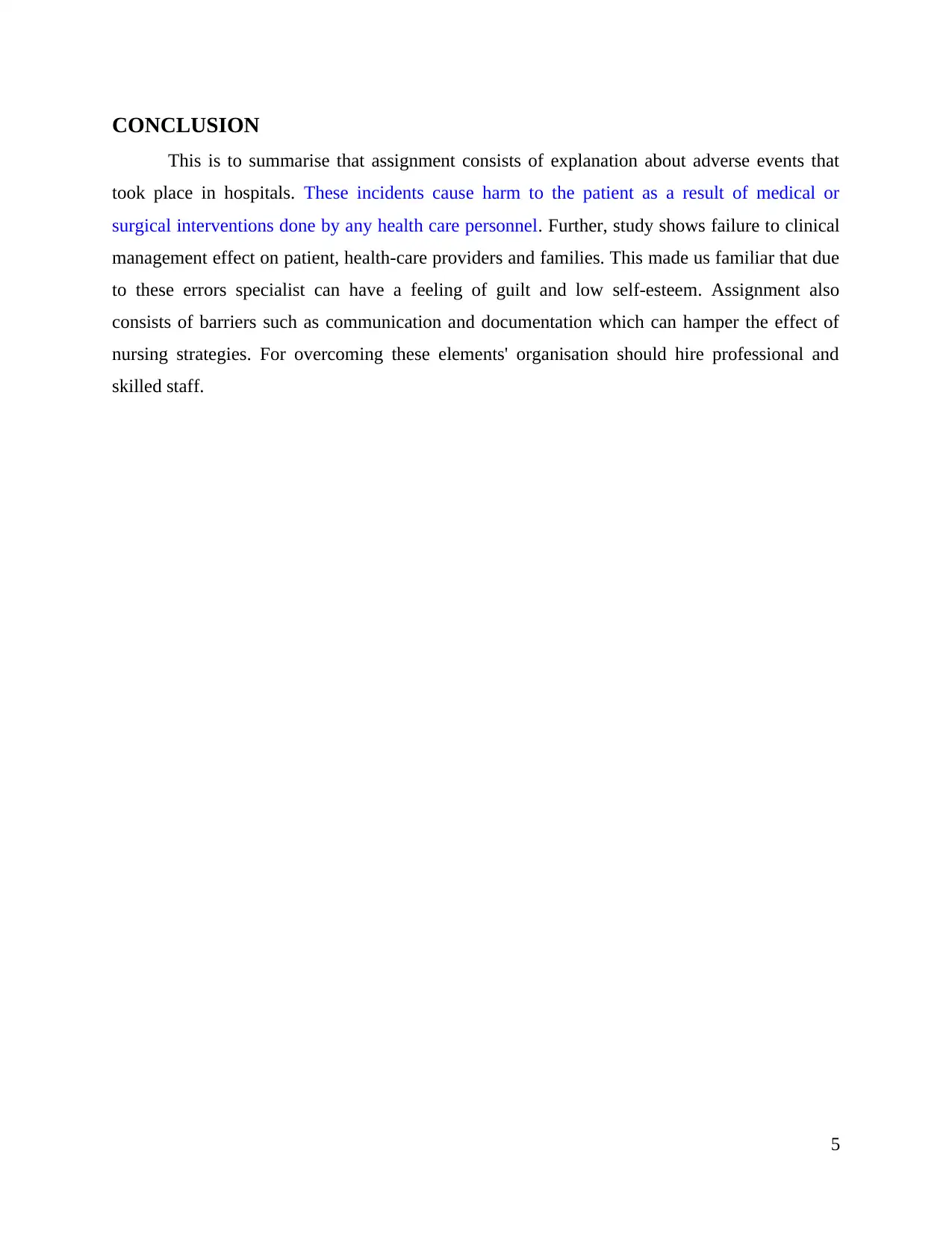
CONCLUSION
This is to summarise that assignment consists of explanation about adverse events that
took place in hospitals. These incidents cause harm to the patient as a result of medical or
surgical interventions done by any health care personnel. Further, study shows failure to clinical
management effect on patient, health-care providers and families. This made us familiar that due
to these errors specialist can have a feeling of guilt and low self-esteem. Assignment also
consists of barriers such as communication and documentation which can hamper the effect of
nursing strategies. For overcoming these elements' organisation should hire professional and
skilled staff.
5
This is to summarise that assignment consists of explanation about adverse events that
took place in hospitals. These incidents cause harm to the patient as a result of medical or
surgical interventions done by any health care personnel. Further, study shows failure to clinical
management effect on patient, health-care providers and families. This made us familiar that due
to these errors specialist can have a feeling of guilt and low self-esteem. Assignment also
consists of barriers such as communication and documentation which can hamper the effect of
nursing strategies. For overcoming these elements' organisation should hire professional and
skilled staff.
5
⊘ This is a preview!⊘
Do you want full access?
Subscribe today to unlock all pages.

Trusted by 1+ million students worldwide
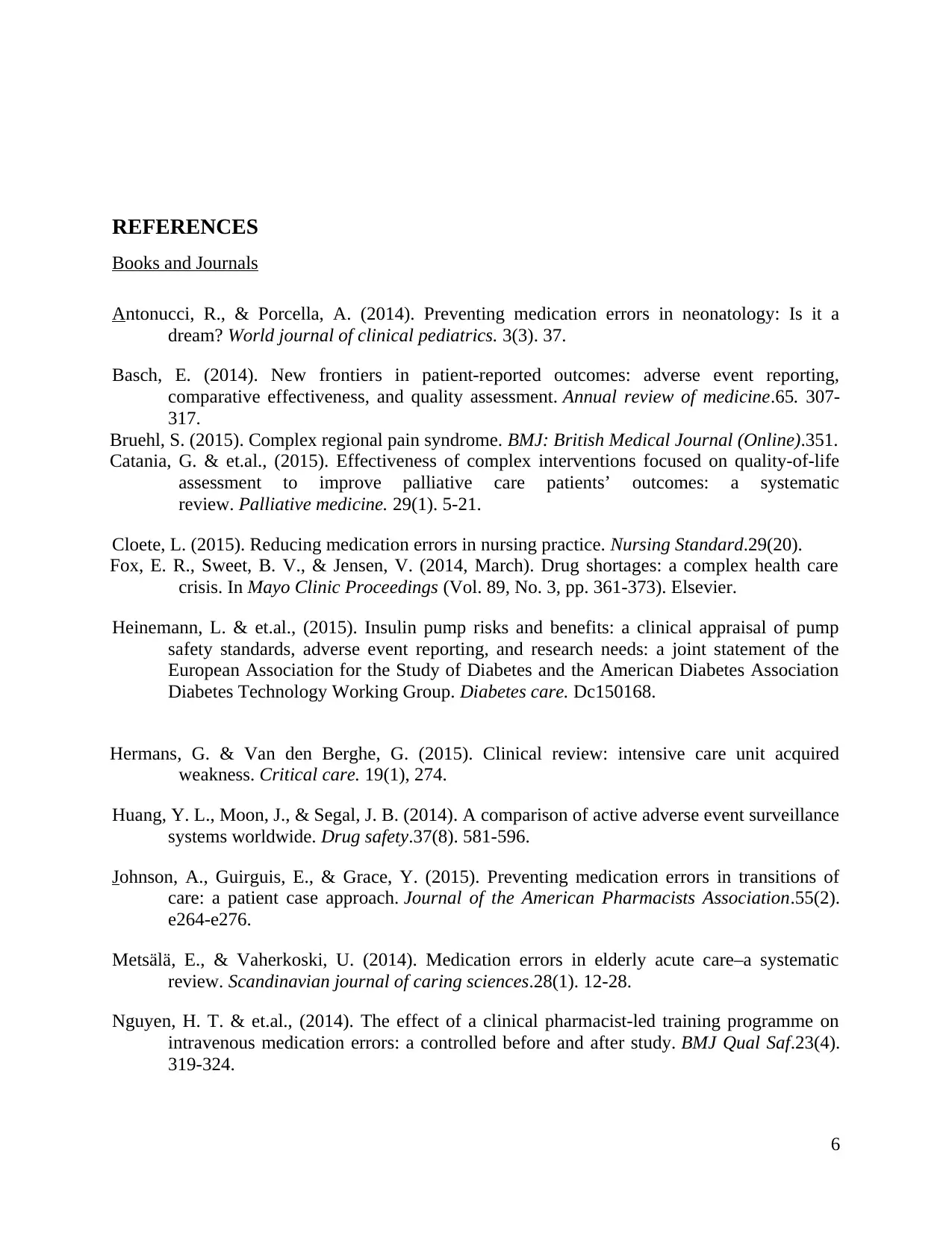
REFERENCES
Books and Journals
Antonucci, R., & Porcella, A. (2014). Preventing medication errors in neonatology: Is it a
dream? World journal of clinical pediatrics. 3(3). 37.
Basch, E. (2014). New frontiers in patient-reported outcomes: adverse event reporting,
comparative effectiveness, and quality assessment. Annual review of medicine.65. 307-
317.
Bruehl, S. (2015). Complex regional pain syndrome. BMJ: British Medical Journal (Online).351.
Catania, G. & et.al., (2015). Effectiveness of complex interventions focused on quality-of-life
assessment to improve palliative care patients’ outcomes: a systematic
review. Palliative medicine. 29(1). 5-21.
Cloete, L. (2015). Reducing medication errors in nursing practice. Nursing Standard.29(20).
Fox, E. R., Sweet, B. V., & Jensen, V. (2014, March). Drug shortages: a complex health care
crisis. In Mayo Clinic Proceedings (Vol. 89, No. 3, pp. 361-373). Elsevier.
Heinemann, L. & et.al., (2015). Insulin pump risks and benefits: a clinical appraisal of pump
safety standards, adverse event reporting, and research needs: a joint statement of the
European Association for the Study of Diabetes and the American Diabetes Association
Diabetes Technology Working Group. Diabetes care. Dc150168.
Hermans, G. & Van den Berghe, G. (2015). Clinical review: intensive care unit acquired
weakness. Critical care. 19(1), 274.
Huang, Y. L., Moon, J., & Segal, J. B. (2014). A comparison of active adverse event surveillance
systems worldwide. Drug safety.37(8). 581-596.
Johnson, A., Guirguis, E., & Grace, Y. (2015). Preventing medication errors in transitions of
care: a patient case approach. Journal of the American Pharmacists Association.55(2).
e264-e276.
Metsälä, E., & Vaherkoski, U. (2014). Medication errors in elderly acute care–a systematic
review. Scandinavian journal of caring sciences.28(1). 12-28.
Nguyen, H. T. & et.al., (2014). The effect of a clinical pharmacist-led training programme on
intravenous medication errors: a controlled before and after study. BMJ Qual Saf.23(4).
319-324.
6
Books and Journals
Antonucci, R., & Porcella, A. (2014). Preventing medication errors in neonatology: Is it a
dream? World journal of clinical pediatrics. 3(3). 37.
Basch, E. (2014). New frontiers in patient-reported outcomes: adverse event reporting,
comparative effectiveness, and quality assessment. Annual review of medicine.65. 307-
317.
Bruehl, S. (2015). Complex regional pain syndrome. BMJ: British Medical Journal (Online).351.
Catania, G. & et.al., (2015). Effectiveness of complex interventions focused on quality-of-life
assessment to improve palliative care patients’ outcomes: a systematic
review. Palliative medicine. 29(1). 5-21.
Cloete, L. (2015). Reducing medication errors in nursing practice. Nursing Standard.29(20).
Fox, E. R., Sweet, B. V., & Jensen, V. (2014, March). Drug shortages: a complex health care
crisis. In Mayo Clinic Proceedings (Vol. 89, No. 3, pp. 361-373). Elsevier.
Heinemann, L. & et.al., (2015). Insulin pump risks and benefits: a clinical appraisal of pump
safety standards, adverse event reporting, and research needs: a joint statement of the
European Association for the Study of Diabetes and the American Diabetes Association
Diabetes Technology Working Group. Diabetes care. Dc150168.
Hermans, G. & Van den Berghe, G. (2015). Clinical review: intensive care unit acquired
weakness. Critical care. 19(1), 274.
Huang, Y. L., Moon, J., & Segal, J. B. (2014). A comparison of active adverse event surveillance
systems worldwide. Drug safety.37(8). 581-596.
Johnson, A., Guirguis, E., & Grace, Y. (2015). Preventing medication errors in transitions of
care: a patient case approach. Journal of the American Pharmacists Association.55(2).
e264-e276.
Metsälä, E., & Vaherkoski, U. (2014). Medication errors in elderly acute care–a systematic
review. Scandinavian journal of caring sciences.28(1). 12-28.
Nguyen, H. T. & et.al., (2014). The effect of a clinical pharmacist-led training programme on
intravenous medication errors: a controlled before and after study. BMJ Qual Saf.23(4).
319-324.
6
Paraphrase This Document
Need a fresh take? Get an instant paraphrase of this document with our AI Paraphraser
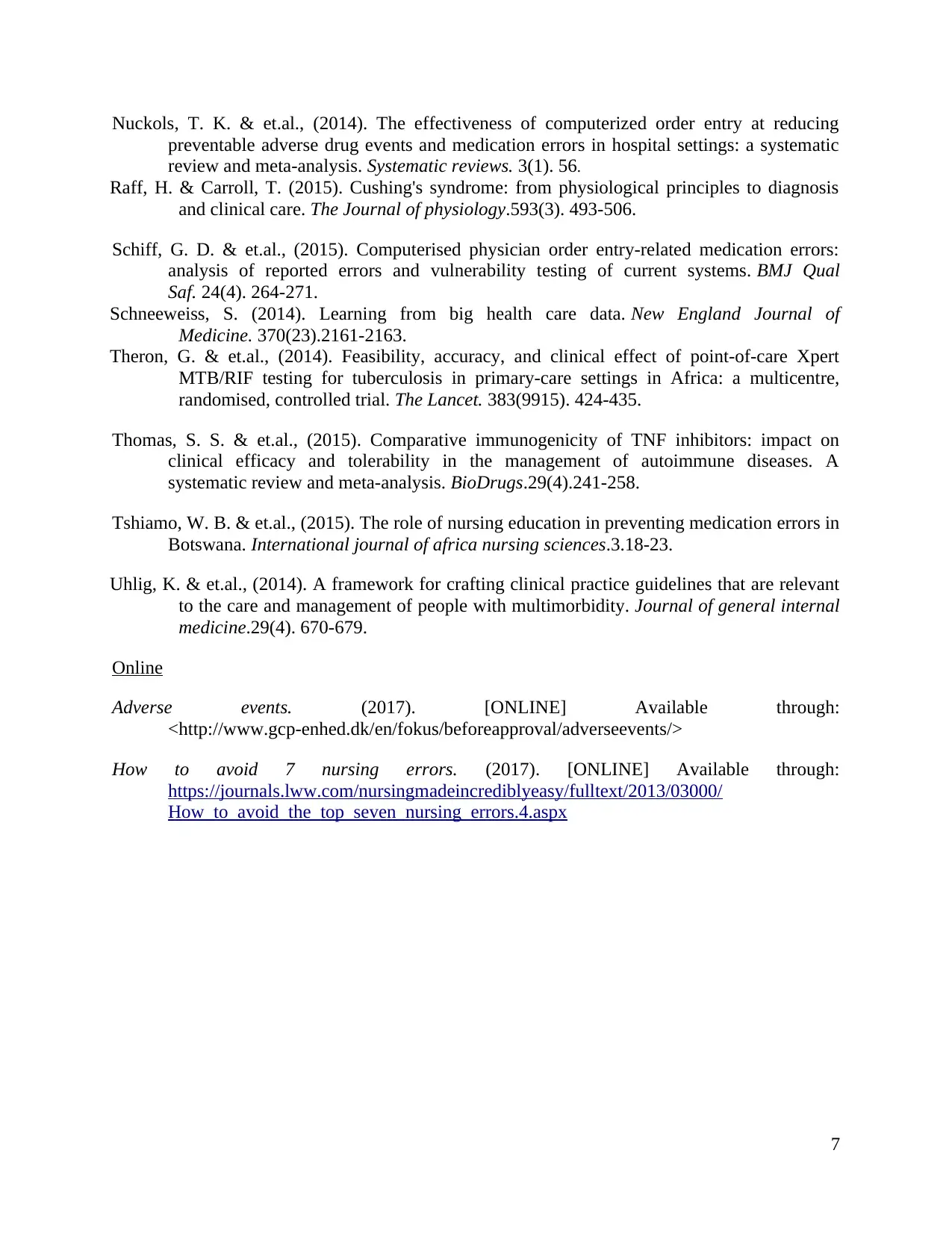
Nuckols, T. K. & et.al., (2014). The effectiveness of computerized order entry at reducing
preventable adverse drug events and medication errors in hospital settings: a systematic
review and meta-analysis. Systematic reviews. 3(1). 56.
Raff, H. & Carroll, T. (2015). Cushing's syndrome: from physiological principles to diagnosis
and clinical care. The Journal of physiology.593(3). 493-506.
Schiff, G. D. & et.al., (2015). Computerised physician order entry-related medication errors:
analysis of reported errors and vulnerability testing of current systems. BMJ Qual
Saf. 24(4). 264-271.
Schneeweiss, S. (2014). Learning from big health care data. New England Journal of
Medicine. 370(23).2161-2163.
Theron, G. & et.al., (2014). Feasibility, accuracy, and clinical effect of point-of-care Xpert
MTB/RIF testing for tuberculosis in primary-care settings in Africa: a multicentre,
randomised, controlled trial. The Lancet. 383(9915). 424-435.
Thomas, S. S. & et.al., (2015). Comparative immunogenicity of TNF inhibitors: impact on
clinical efficacy and tolerability in the management of autoimmune diseases. A
systematic review and meta-analysis. BioDrugs.29(4).241-258.
Tshiamo, W. B. & et.al., (2015). The role of nursing education in preventing medication errors in
Botswana. International journal of africa nursing sciences.3.18-23.
Uhlig, K. & et.al., (2014). A framework for crafting clinical practice guidelines that are relevant
to the care and management of people with multimorbidity. Journal of general internal
medicine.29(4). 670-679.
Online
Adverse events. (2017). [ONLINE] Available through:
<http://www.gcp-enhed.dk/en/fokus/beforeapproval/adverseevents/>
How to avoid 7 nursing errors. (2017). [ONLINE] Available through:
https://journals.lww.com/nursingmadeincrediblyeasy/fulltext/2013/03000/
How_to_avoid_the_top_seven_nursing_errors.4.aspx
7
preventable adverse drug events and medication errors in hospital settings: a systematic
review and meta-analysis. Systematic reviews. 3(1). 56.
Raff, H. & Carroll, T. (2015). Cushing's syndrome: from physiological principles to diagnosis
and clinical care. The Journal of physiology.593(3). 493-506.
Schiff, G. D. & et.al., (2015). Computerised physician order entry-related medication errors:
analysis of reported errors and vulnerability testing of current systems. BMJ Qual
Saf. 24(4). 264-271.
Schneeweiss, S. (2014). Learning from big health care data. New England Journal of
Medicine. 370(23).2161-2163.
Theron, G. & et.al., (2014). Feasibility, accuracy, and clinical effect of point-of-care Xpert
MTB/RIF testing for tuberculosis in primary-care settings in Africa: a multicentre,
randomised, controlled trial. The Lancet. 383(9915). 424-435.
Thomas, S. S. & et.al., (2015). Comparative immunogenicity of TNF inhibitors: impact on
clinical efficacy and tolerability in the management of autoimmune diseases. A
systematic review and meta-analysis. BioDrugs.29(4).241-258.
Tshiamo, W. B. & et.al., (2015). The role of nursing education in preventing medication errors in
Botswana. International journal of africa nursing sciences.3.18-23.
Uhlig, K. & et.al., (2014). A framework for crafting clinical practice guidelines that are relevant
to the care and management of people with multimorbidity. Journal of general internal
medicine.29(4). 670-679.
Online
Adverse events. (2017). [ONLINE] Available through:
<http://www.gcp-enhed.dk/en/fokus/beforeapproval/adverseevents/>
How to avoid 7 nursing errors. (2017). [ONLINE] Available through:
https://journals.lww.com/nursingmadeincrediblyeasy/fulltext/2013/03000/
How_to_avoid_the_top_seven_nursing_errors.4.aspx
7
1 out of 11
Related Documents
Your All-in-One AI-Powered Toolkit for Academic Success.
+13062052269
info@desklib.com
Available 24*7 on WhatsApp / Email
![[object Object]](/_next/static/media/star-bottom.7253800d.svg)
Unlock your academic potential
Copyright © 2020–2025 A2Z Services. All Rights Reserved. Developed and managed by ZUCOL.





